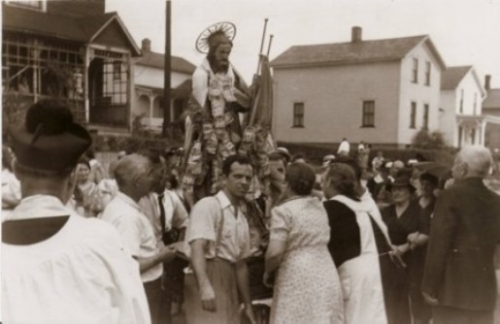Youngstown, Ohio, never developed a centralized little Italy. Instead, the city's mostly southern Italian settlers chose to live near the foundries, rail yards, and steel mills where Germans, Spaniards, Welsh, Slavs, Irish, African American, and others also called home. Of these the two most iconic neighborhoods that boasted large Italian populations were Brier Hill, for a long time an independent village, and Smoky Hollow, close to Youngstown's downtown.
In 1907, a group of Italian-speaking parishioners in Brier Hill left St. Anthony's Roman Catholic Church to found their own parish with the name of Saint Rocco. Resentment of Bishop Horstmann's plans for St. Anthony may have caused the exodus. The shock waves from this unauthorized move reverberated for decades in the local Italian American community owing to the fact that Protestantism in the "old country" was unknown. Now Brier Hill had two Italian nationality churches: one in communion with Rome and the other boldly independent.
After a decade of staffing and financial difficulties, St. Rocco's Church sat abandoned and repossessed by the bank. Its parishioners lacked clergy to perform baptisms, marriages, and funerals. The dire situation of so many Italian Christians prompted help from a local Episcopal priest. Under the direction of the Episcopal Diocese of Ohio, Father Izon of St. Andrews enlisted the Italian-born Father Oreste Salcini to minister to the needs of St Rocco's congregation.
On June 15, 1918, 80 families of St. Rocco's were received into the Protestant Episcopal Church. Under Fr. Salcini's leadership, the congregation of St. Rocco's Episcopal Church returned to the original building, repurchased it from the bank, and began to attract new members from Youngstown's growing Italian community. All this occurred as St. Anthony's experienced similar growth. Added to the notoriety of a Protestant church serving Brier Hill was the fact that often St. Rocco's clergy were married. Despite traditional prohibitions against Catholic attendance at Protestant rites, the annual procession every August 16 found many Mahoning Valley Italians-regardless of religious affiliation- marching in the long procession behind the statue of St. Rocco.
With the 1957 conversion of West Federal Street to route 422, St. Rocco's Church relocated to Trumbull Avenue, Liberty Township. For many years the church remained a center for Italian Americans, though now it served a more ethnically mixed congregation. By the late 1990s, dropping attendance led to the sad realization that the parish would have to close. Nonetheless, at the final Mass on New Years Eve of 2006, the beautiful lyrics of Tu Scendi delle Stelle could still be heard.
The story of Brier Hill's St. Rocco's Church offers one example of the many changes the Italian community experienced as it became settled in the Mahoning Valley. No longer defined by age-old identities, local Italians of the previous century appraised their new American surroundings and opted to exercise new rights. Along the way, these immigrants redefined themselves in a multi-religious United States.



